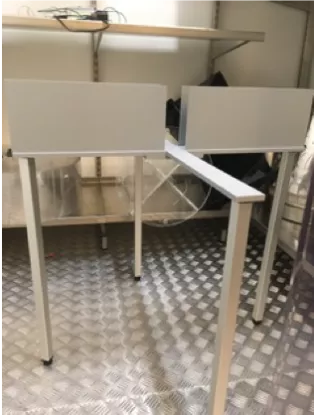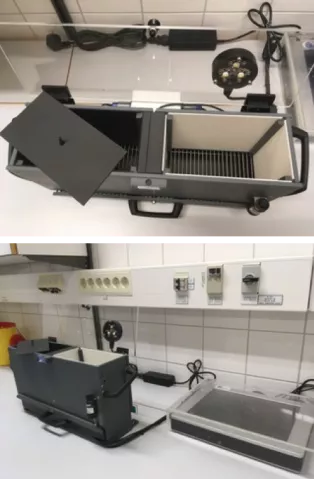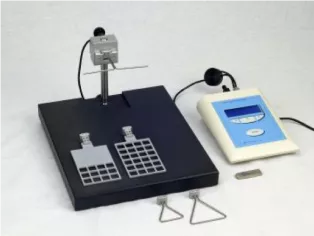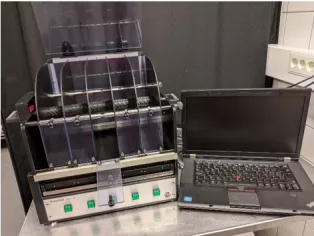Mouse Behavioral Platform
Information on the mouse behavioral platform
Test rooms and booking
The mouse behavioral platform comprises the following test rooms:
BMC room C1044:
(front) Flexible space module for y-maze, elevated plus maze, and passive avoidance test.
(back) Barnes Maze.
BMC room BMC C1042:
(front) Flexible space module for motor tests including rotarod, corridor test, grip strength meter, cylinder test (equipped with mirrors and mobile videocamera).
(back) Open field video-tracking system for 8 boxes.
BMC room A0934:
Extra room available for mobile tests (in case the other rooms are overbooked).
Booking procedure
To access the platform you need to be introduced by the appointed manager, Elena Espa. You can request to book time for the introduction by sending an e-mail to elena [dot] espa [at] med [dot] lu [dot] se.
Once you are introduced you can book time on a test apparatus as described below:
1) Open your outlook mail
2) Select calendar on the top right corner of the page
3) Click “Add Calendar" and then “From Directory”
4) Type the name of the room who want to book:
C1042a Front
C1042a Back/open field
C1044a Front
C1044a Back/Barnes Maze
5) Choose a room: the available time will be shown in the list. You can also click on ‘Scheduling Assistant to check free/busy time for multiple rooms …’
6) Select the time slot you want to book and click on ‘send’. A confirmation of your booking will be sent to you shortly.
Description of larger test equipment
The Elevated Plus Maze (EPM) test is used to assess anxiety-related behaviour by measuring the preference for being in open arms over closed arms.
REFERENCE:
Walf and Frye, Nat Protoc. 2007; 2(2): 322–328. doi: 10.1038/nprot.2007.44)
The Y-maze is usually employed to assess hippocampal-dependent spatial memory by measuring the spontaneous alternation behaviour in a Y-maze.
REFERENCES:
Duarte et al., Plos One 7(4): e21899, 2012.
Lizarbe et al., Front Neurosci 12:985, 2019.
Passive Avoidance is a fear-motivated test to evaluate cognitive processes in rodents. The chamber is divided into a black compartment and a white illuminated compartment with a gate between both parts. In the habituation phase, mice are allowed to explore both compartments. In the training session, the animal is placed in the white compartment and when it innately crosses to the black compartment, it receives a mild foot shock. Mice will learn to associate that moving to the dark compartment has negative consequences. In the test session, normal mice will avoid entering the dark chamber. Learning and memory capacities are measured by recording the latency to escape from the white compartment.
REFERENCES:
Baarendse PJ, van Grootheest G, Jansen RF, et al. Differential involvement of the dorsal hippocampus in passive avoidance in C57bl/6J and DBA/2J mice. Hippocampus 2008;18(1):11-19.
Madjid N, Tottie EE, Luttgen M, et al. 5-Hydroxytryptamine 1A receptor blockade facilitates aversive learning in mice: interactions with cholinergic and glutamatergic mechanisms. J Pharmacol Exp Ther 2006;316(2):581-591.
The Barnes maze takes advantage of the natural desire of rodents to avoid open, exposed spaces. It consists of a large circular space with 20 holes lining the perimeter. One of the holes has a box underneath it that mice can use to escape the maze, while the others lead to an endless abyss. Visual cues surround the maze to make learning easier. The Barnes maze is similar to the Morris water navigation task and to the radial arm maze task, but does not utilize a strong aversive stimulus (stress induced by swimming such as in the Morris water maze) or deprivation (food or water deprivation such as in the radial arm maze) as reinforcement. Mice performing 1-2 trials per day learn the location of the escape hole within 3-4 days. As with the Morris water maze, escape time, distance traveled, and errors gradually reduce with learning. After training/learning, memory can be tested.
REFERENCES:
O'Leary TP, Brown RE. Optimization of apparatus design and behavioral measures for the assessment of visuo-spatial learning and memory of mice on the Barnes maze. Learn Mem 2013;20(2):85-96.
Mouzon B, Chaytow H, Crynen G, et al. Repetitive mild traumatic brain injury in a mouse model produces learning and memory deficits accompanied by histological changes. J Neurotrauma 2012;29(18):2761-2773.
The Grip Strength Meter is a system for determining the gripping strength of small laboratory animals (rat, mouse). Within the context of neuromuscular investigations this test can be used to quantify the effects of hormones, toxins, muscle relaxants and other manipulations on the muscular strength of the animal.
The open field test with videotracking is an experimental test used to assay general locomotor activity levels, anxiety, and willingness to explore in rodents. The setup consists of eight arenas (transparent and black boxes are interchangeable), one camera per each box and sensors for tracking the vertical activity. The system is operated by the software AnyMaze. Object recognition tasks: Object-recognition memory tasks are based on the spontaneous tendency of rodents to spend more time exploring a new object or an object that has been relocated in the exploration field (e.g. Beilharz et al. Brain Behav Immunity 37: 134, 2014). Such tests assess hippocampal-dependent spatial memory (object placement recognition), or cortical functioning (novel object recognition).
The rotarod test is widely used to assess general motor dexterity in rodents (Zausinger et al. 2000; Luesse et al. 2001; Jeong et al. 2003; Karl et al. 2003). The test measures a mouse ability to maintain itself on a rod that turns at accelerating speeds.
Mouse behavioral platform management group
Angela Cenci Nilsson (Chair)
Professor, Basal Ganglia Pathophysiology
Telefone: +46 46 222 14 31
E-mail: angela [dot] cenci_nilsson [at] med [dot] lu [dot] se
Elena Espa (Platform manager)
Research Engineer, Basal Ganglia Pathophysiology
Email: elena [dot] espa [at] med [dot] lu [dot] se
João Duarte
Senior lecturer, Diabetes and Brain Function
Telefone: +46 72 452 56 31
E-mail: joao [dot] duarte [at] med [dot] lu [dot] se (joao[dot]duarte[at]med[dot]lu[dot]se)
Valentina Cesaroni
Post-doctoral fellow, Basal Ganglia Pathophysiology
E-mail: valentina [dot] cesaroni [at] med [dot] lu [dot] se (valentina[dot]cesaroni[at]med[dot]lu[dot]se)
Carin Sjölund
Research project participant, Laboratory for Experimental Brain Research
E-mail: carin [dot] sjolund [at] med [dot] lu [dot] se
Rana Soylu Kucharz
Post-doctoral researcher, Biomarkers in Brain Disease
E-mail: rana [dot] soylu_kucharz [at] med [dot] lu [dot] se








